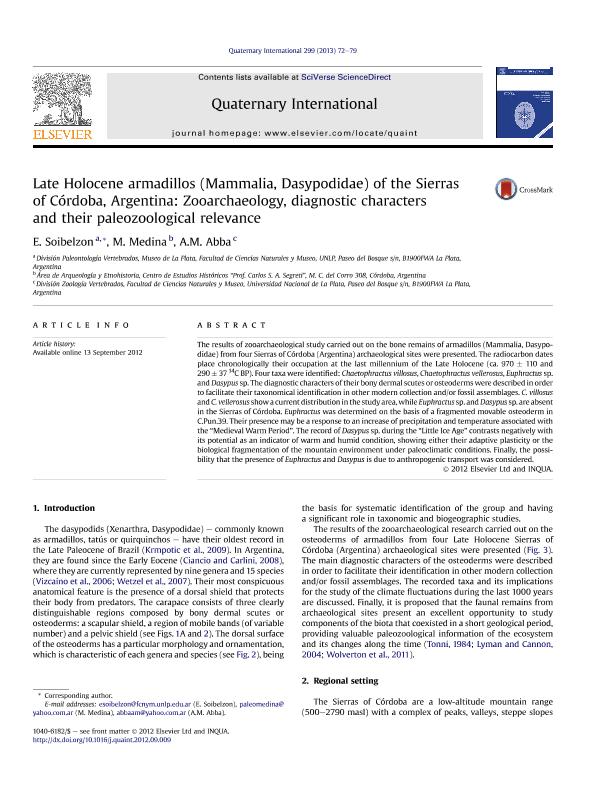Artículo
Late Holocene armadillos (Mammalia, Dasypodidae) of the Sierras of Córdoba, Argentina: Zooarchaeology, diagnostic characters and their paleozoological relevance
Fecha de publicación:
06/2013
Editorial:
Pergamon-Elsevier Science Ltd
Revista:
Quaternary International
ISSN:
1040-6182
Idioma:
Inglés
Tipo de recurso:
Artículo publicado
Clasificación temática:
Resumen
The results of zooarchaeological study carried out on the bone remains of armadillos (Mammalia, Dasypodidae) from four Sierras of Córdoba (Argentina) archaeological sites were presented. The radiocarbon dates place chronologically their occupation at the last millennium of the Late Holocene (ca. 970±110 and 290±3714CBP). Four taxa were identified: Chaetophractus villosus, Chaetophractus vellerosus, Euphractus sp. and Dasypus sp. The diagnostic characters of their bony dermal scutes or osteoderms were described in order to facilitate their taxonomical identification in other modern collection and/or fossil assemblages. C. villosus and C. vellerosus show a current distribution in the study area, while Euphractus sp. and Dasypus sp. are absent in the Sierras of Córdoba. Euphractus was determined on the basis of a fragmented movable osteoderm in C.Pun.39. Their presence may be a response to an increase of precipitation and temperature associated with the "Medieval Warm Period". The record of Dasypus sp. during the "Little Ice Age" contrasts negatively with its potential as an indicator of warm and humid condition, showing either their adaptive plasticity or the biological fragmentation of the mountain environment under paleoclimatic conditions. Finally, the possibility that the presence of Euphractus and Dasypus is due to anthropogenic transport was considered.
Palabras clave:
Archaeofauna
,
Little Ice Age
,
Medieval Warm Period
,
Xenarthra
,
Osteoderm
Archivos asociados
Licencia
Identificadores
Colecciones
Articulos(CCT - CORDOBA)
Articulos de CTRO.CIENTIFICO TECNOL.CONICET - CORDOBA
Articulos de CTRO.CIENTIFICO TECNOL.CONICET - CORDOBA
Articulos(CCT - LA PLATA)
Articulos de CTRO.CIENTIFICO TECNOL.CONICET - LA PLATA
Articulos de CTRO.CIENTIFICO TECNOL.CONICET - LA PLATA
Citación
Soibelzon, Esteban; Medina, Matias Eduardo; Abba, Agustin Manuel; Late Holocene armadillos (Mammalia, Dasypodidae) of the Sierras of Córdoba, Argentina: Zooarchaeology, diagnostic characters and their paleozoological relevance; Pergamon-Elsevier Science Ltd; Quaternary International; 299; 6-2013; 72-79
Compartir
Altmétricas




